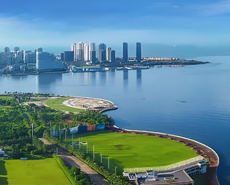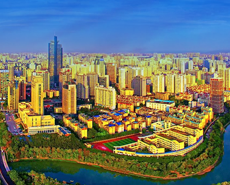
Torngat Metals commits to be a stable and sustainable long-term rare earth supplier
----Interview with Dr. Dirk Naumann
CEO
Torngat Metals Ltd.
CEO
Torngat Metals Ltd.
Torngat Metals is a privately held company headquartered in Montreal, Quebec, Canada. They are trying to be a supplier by 2023 of 11,500t per year of a full range of rare earth products, with a focus on the heavy and light rare earths required for permanent magnets. The company commits to the highest levels of sustainability at all stages in development and operation of the mine and the processing of finished products. Their Strange Lake project is based on developing gadolinite miarolitic pegmatite rare earth resource located in northern Quebec, approximately 240 km northeast of Schefferville. They plan to beneficiate the ore onsite into a rare earth concentrate that will be shipped to southern Quebec for processing into high purity rare earth products for sale, both as separated and mixed rare earth products. Torngat has 274 mining claims totaling 10,941 hectares in the approximately 6 km diameter Strange Lake Alkalic Complex. They are currently focused on the area known as the B Zone, which has a 25+ year mine life.
Asian Metal: Thanks for accepting the interview of Asian Metal, Dirk! Would you like to give a brief introduction of your company firstly?
Dirk: Thank you. Torngat Metals is a privately held company headquartered in Montreal, Quebec, Canada. We are preparing to be a supplier by 2023 of 11,500 tonnes per year of a full range of rare earth products, with a focus on the heavy and light rare earths required for permanent magnets. We are committed to the highest levels of sustainability at all stages in development and operation of the mine and the processing of finished products.
Asian Metal: Would you please to introduce your Strange Lake project?
Dirk: Our Strange Lake project is based on developing our gadolinite miarolitic pegmatite rare earth resource located in northern Quebec, approximately 240 km northeast of Schefferville. After selective mining, we plan to beneficiate the ore onsite into a rare earth concentrate that will be shipped to southern Quebec for processing into high purity rare earth products for sale, both as separated and mixed rare earth products. Torngat has 274 mining claims totaling 10,941 hectares in the approximately 6 km diameter Strange Lake Alkalic Complex. We are currently focused on the area known as the B Zone, which has a 25+ year mine life. With future exploration, we are positioning Torngat to be a very stable and sustainable long-term supplier of rare earth products.

A geological map depicting the Strange Lake Alkalic Complex and the location of the B Zone in Quebec, and the Main Zone in Newfoundland and Labrador.
Asian Metal: From what I understand, Strange Lake project is famous for being a huge rare earth resource. May I know what do you think as the project's other advantages?
Dirk: Yes, it has been well known for years that Strange Lake is one of the world's biggest rare earth resources. We have a number of other significant advantages that make our project favored to be one of the resources that actually goes into production. One advantage is that our resource is high in rare earths with the greatest demand growth, particularly the heavy and light rare earths for permanent magnets. Our ore's rare earth composition is 4.1% of Dysprosium plus Terbium, and 15.8% Neodymium plus Praseodymium. Another advantage is that the rare earths in our ore are relatively easily liberated, enabling low and very competitive production costs. The Strange Lake Project also has the advantage of being in one of the most geopolitically stable regions that is also very supportive of resource development and mining, particularly in the northern regions where Strange Lake is located.
Asian Metal: Developing a rare earth project is always a challenging work. Would you like to introduce what is the biggest challenge you are facing at the moment?
Dirk: Like many rare earth projects, and mining projects in general, our challenge is to access financing to match our stage of development. We are addressing this challenge by identifying the areas to work on that will add the most to the project's value and reduce its risks. This approach has driven our technical workplan for 2018, the results of which are that we have increased confidence in our mining, beneficiation and processing flowsheets and our new and significantly reduced cost estimates.
Asian Metal: As far as I know, Torngat Metals did a lot of geological work in 2018. Could you share the latest results?
Dirk: Yes in 2018 we undertook a comprehensive review and reconstruction of our geological model, as well the mine site beneficiation flowsheet. Our focus is to aggressively drive down the capital and operating cost estimates and take full advantage of the unique mineralogy of our resource. Using our new geological model, the dominant rare earth-bearing minerals and their textures can now be related to the rare earth element grade of a rock type, unit, or subdomain. These relationships will be used to optimize mining and mineral processing plans.

Photographs that depict the natural breakage characteristics of the rocks due to blasting. Using these natural properties of the rock it is anticipated that blasting can be used as an additional liberation method for separating relatively higher-graded fine material (left image) from relatively lower grade coarse material (right image).
We have determined that the B-Zone contains an "enriched domain" which hosts the rock types, textures and minerals that contain the highest concentration of permanent magnet rare earths. The "enriched domain" can be divided into discrete subdomains that represent traceable zones with clearly defined contacts. The new geological model will enable selective mining of high-grade ore (50-100% head grade increase compared to previous estimates) for 25 years.
We are currently conducting pilot testing with a composition sample indicative of the "Enriched Zone" to test the ease of liberation of rare earth-bearing minerals that are present as interstitial aggregates, along grains boundaries and in fractures. We are confirming that we will be able to remove more of the gangue material more quickly, at each processing step. We are testing a staged approach, allowing the simple liberation of rare earth-bearing minerals into the fine fraction, significantly reducing the cost of crushing and grinding. After removal of the initially easily liberated rare earth-bearing minerals, the coarser fraction is being piloted through X-ray transmission sorting, attrition milling, and magnetic separation. We estimate that we will be able to achieve a significant increase (200-300% compared to previous estimates) in the concentration of the rare earth concentrate that is shipped from Strange Lake. These developments are enabling us to significantly reduce the capital and operating cost estimates at mine site as well as for the processing plant in southern Quebec.

Image of ore sample showing net texture of fine grain rare earth minerals between coarser gangue minerals.















